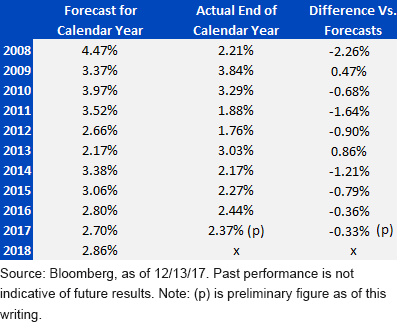U.S. Fixed Income: Nostradamus Has Nothing to Fear


For those readers who are not aware of Nostradamus, he is viewed as being one of history’s better prognosticators. Granted, he never had the difficult assignment of trying to forecast the direction of the U.S. Treasury (UST) 10-Year yield, but given the track record of projections over the last decade, it becomes readily apparent that Nostradamus would have had little to fear from a reputational standpoint.
The table below highlights what the consensus forecasts were for the UST 10-Year yield beginning in 2008 through the present (10 observations), what the actual yield was to end that calendar year and, of course, any difference that may have existed between the two. The current year is still not final, so I am using the UST 10-Year yield as of this writing, while the 2018 number is the latest forecast available. The results are not too comforting for those in the forecasting business, to say the least, and underscores the point that the estimates should be used more as a talking point and not necessarily as a basis to use when implementing a fixed income portfolio (more on this later).
UST 10-Year Yield Forecasts vs. Actuals

Let’s take a quick look at the results. Of the 10 projections, 8 have come in too high, while only 2 were lower than the actual respective year-end level. In other words, over the last 10 years, 80% of the time the UST 10-Year yield ended up being lower than the forecast. Some of the magnitudes of these differences have been notable as well: -226 basis points (bps) in 2008, -164 bps in 2011 and -121 bps in 2014, to name the top three largest variations. It is interesting to note that the UST 10-Year forecasts have missed to the upside for the last four years (assuming 2017 continues to play out as present), with the average miss potentially being -67 bps.
Let’s return to the point I mentioned earlier. Should target forecasts be seen as integral in the investment process? I always have held to the belief that a year-end projection is just a snapshot and investors should look at trading ranges as a more useful tool. Let’s take 2017 as an example, where the UST 10-Year yield has traded between a low point of 2.04% to a high watermark of 2.63%. If you were one of the forecasters who predicted the consensus estimate of 2.70%, you probably felt pretty good in March when the aforementioned high point was printed. However, after Labor Day, when the trough was recorded, you may have been thinking about going back to the drawing board. Instead, if you were to look at it from a trading range point of view, you could have acknowledged the changing dynamics that can occur in any given calendar year, and that the overall trend for the year as a whole essentially has been unchanged: December 30, 2016—2.44%; Dec. 13, 2017—2.37%.
Conclusion
The WisdomTree outlook for the UST 10-Year yield continues to see range-bound behavior for 2018. We expect to see a pattern somewhat similar to this year’s, where the band could move between 2.25% and 2.65%. Depending upon flight-to-quality concerns, we would not rule out a temporary move toward the 2.00% threshold. Meanwhile, any upside surprises to inflation or unexpected central bank policy shifts, where the “foot comes off the accelerator” in places such as the eurozone, the yield could test the upper band of this range. Against this backdrop, investors should consider the WisdomTree Barclays Yield Enhanced U.S. Aggregate Bond Fund (AGGY) to maintain their core fixed income exposure, with a focus on income.
Investors looking to mitigate potential interest rate exposure may wish to examine the benefit of floating rate Treasury notes (FRNs). FRNs are based on a reference rate that is determined at the weekly three-month Treasury bill auction. As a result, they have the potential to reset interest rates more frequently as short-term yields drift higher. Given the Fed’s recent forecast of three additional increases in the Fed Funds Rate in 2018, some “Fed protection” seems warranted. Against this backdrop, due to the weekly reset feature of Treasury FRNs, we feel that by utilizing a floating rate product, such as the WisdomTree Bloomberg Floating Rate Treasury Fund (USFR), investors may be better able to insulate their bond portfolio from a purely Fed rate hike perspective.
Unless otherwise noted, data source is Bloomberg, as of December 13, 2017.
Important Risks Related to this Article
There are risks associated with investing, including possible loss of principal. Securities with floating rates can be less sensitive to interest rate changes than securities with fixed interest rates, but may decline in value. The issuance of floating rate notes by the U.S. Treasury is new and the amount of supply will be limited. Fixed income securities will normally decline in value as interest rates rise and are subject to interest rate risk. Fixed income investments are also subject to credit risk, the risk that the issuer of a bond will fail to pay interest and principal in a timely manner, or that negative perceptions of the issuer’s ability to make such payments will cause the price of that bond to decline. Investing in mortgage- and asset-backed securities involves interest rate, credit, valuation, extension and liquidity risks and the risk that payments on the underlying assets are delayed, prepaid, subordinated or defaulted on. Due to the investment strategy of the Fund, it may make higher capital gain distributions than other ETFs. The value of an investment in the Fund may change quickly and without warning in response to issuer or counterparty defaults and changes in the credit ratings of the Fund’s portfolio investments. Due to the investment strategy of this Fund it may make higher capital gain distributions than other ETFs. Please read the Fund’s prospectus for specific details regarding the Fund’s risk profile.


